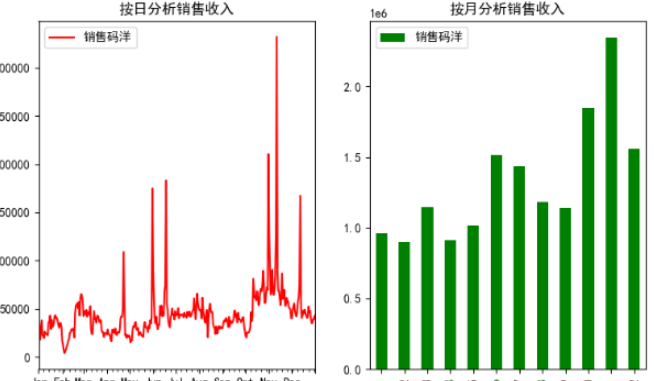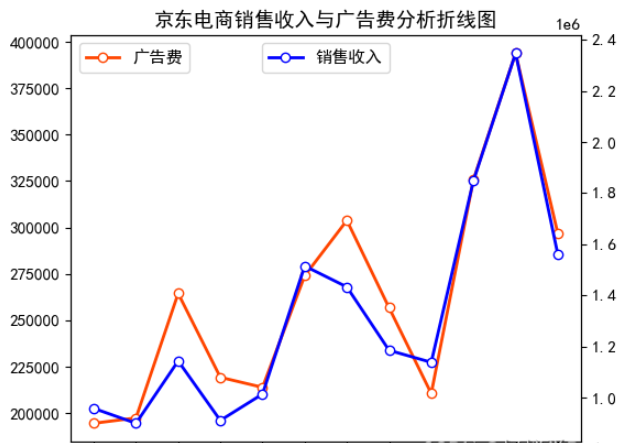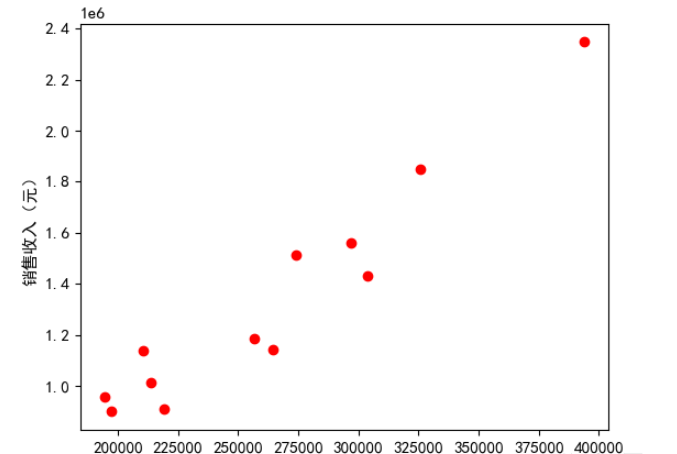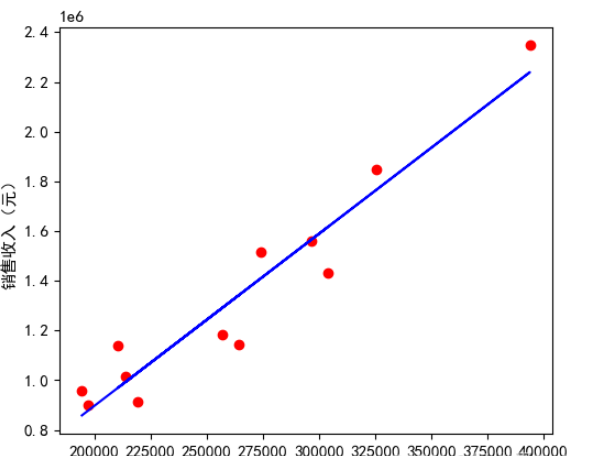您现在的位置是:首页 >其他 >matplotlib运用:电商广告投入及销量预测【数据集+完整代码】网站首页其他
matplotlib运用:电商广告投入及销量预测【数据集+完整代码】
简介matplotlib运用:电商广告投入及销量预测【数据集+完整代码】
前期准备
数据准备
数据集有两个表
- 销售数据表
- 投放费用的广告费用表
文章源码获取方式 ?? 点击文末名片
1. 分别按 日 和 月 分析销售收入
绘制子图
figure(num=None, figsize=None, dpi=None, facecolor=None, edgecolor=None,frameon=True)
num:图像编号或名称.数字为编号,字符串为名称
figsize:指定figure的宽和高.单位为英寸
dpi参数指定绘图对象的分辨率,即每英寸多少个像素,缺省值为80 1英寸等于2.5cm,A4纸是21*30cm的纸张
facecolor:背景颜色
edgecolor:边框颜色
frameon:是否显示边框
(1 ) subplot语法
subplot(nrows,ncols,sharex,sharey,subplot_kw.**fig_kw)
nrows subplot的行数
ncols subplot的列数
sharex 所有subplot应该使用相同的X轴刻度.(调节xlim将会影响所有subplot)
sharey 所有subplot应该使用相同的Y轴刻度(调节ylim将会影响所有subplot)
subplot_kw 用于创建各subplot的关键字字典
**fig_kw 创建figure时的其他关键字,如plt.subplots(2,2,figsize=(8,6))
import pandas as pd
import matplotlib.pyplot as plt
pd.set_option('display.unicode.east_asian_width', True)
df = pd.read_excel('.data销售表.xlsx')
df = df[['日期', '销售码洋']]
df['日期'] = pd.to_datetime(df['日期'])
df1 = df.set_index('日期')
df_d = df1.resample('D').sum().to_period('D')
df_d.to_excel(r'.
esult
esult1.xlsx')
df_m = df1.resample('M').sum().to_period('M')
df_m.to_excel(r'.
esult
esult2.xlsx')
plt.rc('font', family='SimHei', size=10)
fig = plt.figure(figsize=(9, 5))
ax = fig.subplots(1, 2)
ax[0].set_title('按日分析销售收入') # 设置图表标题
df_d.plot(kind='line', ax=ax[0], color='r')
ax[1].set_title('按月分析销售收入') # 设置图表标题
df_m.plot(kind='bar', ax=ax[1], color='g')
plt.subplots_adjust(top=0.95, bottom=0.18)
plt.savefig(r'.
esult�1_sales.png') # 保存图片
plt.show()

接着我们开始研究投放的广告费用与销量存在的相关关系,
如果相关度高,
我们即可以利用广告费用来预测销售量。
2. 按月份分析广告费用与销售收入
import pandas as pd
import matplotlib.pyplot as plt
源码领取+wx:xiaoyuanllsll
df1 = pd.read_excel('.data广告费.xlsx')
df2 = pd.read_excel('.data销售表.xlsx')
df2 = df2[['日期', '销售码洋']]
# 将日期转换为日期格式
df1['投放日期'] = pd.to_datetime(df1['投放日期'])
df2['日期'] = pd.to_datetime(df2['日期'])
df1 = df1.set_index('投放日期')
df2 = df2.set_index('日期')
df_y1 = df1.resample('M').sum().to_period('M') # 按月统计广告费
df_y2 = df2.resample('M').sum().to_period('M') # 按月统计销售码洋
y1 = pd.DataFrame(df_y1['支出']) # 广告费支出
y2 = pd.DataFrame(df_y2['销售码洋']) # 销售码洋
plt.rc('font', family='SimHei', size=10)
fig = plt.figure()
ax1 = fig.add_subplot(111)
plt.title('京东电商销售收入与广告费分析折线图')
x_ticks = [1, 2, 3, 4, 5, 6, 7, 8, 9, 10, 11, 12]
x_label = ['1月', '2月', '3月', '4月', '5月', '6月', '7月', '8月', '9月', '10月', '11月', '12月']
plt.xticks(x_ticks, x_label)
ax1.plot(x_ticks, y1, color='orangered', linewidth=2, linestyle='-', marker='o', mfc='w', label='广告费')
plt.legend(loc='upper left')
ax2 = ax1.twinx()
ax2.plot(x_ticks, y2, color='g', linewidth=2, linestyle='-', marker='o', mfc='w', label='销售收入')
plt.legend(loc='upper center')
plt.subplots_adjust(right=0.85)
plt.savefig(r'.
esult�2_line.png')
plt.show()

从上图我们可以发现广告费和销量收入的走势基本相同,
下面我们还可以通过广告费用与销量收入的散点图来验证。
3. 广告费用与销量收入之间的散点图
import pandas as pd
import matplotlib.pyplot as plt
df1 = pd.read_excel('.data广告费.xlsx')
df2 = pd.read_excel('.data销售表.xlsx')
df2 = df2[['日期', '销售码洋']]
df1['投放日期'] = pd.to_datetime(df1['投放日期'])
df2['日期'] = pd.to_datetime(df2['日期'])
df1 = df1.set_index('投放日期', drop=True)
df2 = df2.set_index('日期', drop=True)
df_x = df1.resample('M').sum().to_period('M')
df_y = df2.resample('M').sum().to_period('M')
x = pd.DataFrame(df_x['支出'])
y = pd.DataFrame(df_y['销售码洋'])
plt.rc('font', family='SimHei', size=11)
plt.figure("京东电商销售收入与广告费分析散点图")
plt.scatter(x, y, color='r')
plt.xlabel('广告费(元)')
plt.ylabel('销售收入(元)')
plt.subplots_adjust(left=0.15)
plt.savefig(r'.
esult�3_scatter.png')
plt.show()

我们发现,
两者的确在一个线条区域上,
可以基本判别两者存在相关关系。
接下来我们就可以利用
线性回归方程
通过投放的广告费用来预测销售收入。
4. 线性回归方程通过投放的广告费用来预测销售收入
import pandas as pd
from sklearn import linear_model
import matplotlib.pyplot as plt
import numpy as np
df1 = pd.read_excel('.data广告费.xlsx')
df2 = pd.read_excel('.data销售表.xlsx')
df2 = df2[['日期', '销售码洋']]
df1['投放日期'] = pd.to_datetime(df1['投放日期'])
df2['日期'] = pd.to_datetime(df2['日期'])
df1 = df1.set_index('投放日期', drop=True)
df2 = df2.set_index('日期', drop=True)
df_x = df1.resample('M').sum().to_period('M')
df_y = df2.resample('M').sum().to_period('M')
x = pd.DataFrame(df_x['支出'])
y = pd.DataFrame(df_y['销售码洋'])
clf = linear_model.LinearRegression()
clf.fit(x, y)
k = clf.coef_
b = clf.intercept_
print('回归系数k:', k, '截距b:', b)
x0 = np.array([120000, 130000, 150000, 180000, 200000, 250000])
x0 = x0.reshape(6, 1)
y0 = clf.predict(x0)
print('预测销售收入:')
print(y0)
y_pred = clf.predict(x)
plt.rc('font', family='SimHei', size=11)
plt.figure("京东电商销售数据分析与预测")
plt.scatter(x, y, color='r')
plt.plot(x, y_pred, color='blue', linewidth=1.5)
plt.xlabel('广告费(元)')
plt.ylabel('销售收入(元)')
plt.subplots_adjust(left=0.15)
plt.savefig(r'.
esult�4_pred.png')
plt.show()
from sklearn.metrics import r2_score
y_true = [360000, 450000, 600000, 800000, 920000, 1300000]
score = r2_score(y_true, y0)
print("预测评分")
print(score)

回归系数k: [[6.92235616]] 截距b: [-487521.71147034]
预测销售收入:
[[ 343161.02820353]
[ 412384.58984301]
[ 550831.71312199]
[ 758502.39804046]
[ 896949.52131943]
[1243067.32951688]]
预测评分
0.9839200886906196
总结
最后我们对算法进行检验,
验证该算法的有效性。
利用带标签的数据,
与回归方程的预测值作比较。
常用的损失函数为:MSE(误差平方和)
最后得分为 0.9839200886906198(得分,也可做准确率)
说明这回归方程还是预测效果很好的。
风语者!平时喜欢研究各种技术,目前在从事后端开发工作,热爱生活、热爱工作。






 U8W/U8W-Mini使用与常见问题解决
U8W/U8W-Mini使用与常见问题解决 QT多线程的5种用法,通过使用线程解决UI主界面的耗时操作代码,防止界面卡死。...
QT多线程的5种用法,通过使用线程解决UI主界面的耗时操作代码,防止界面卡死。... stm32使用HAL库配置串口中断收发数据(保姆级教程)
stm32使用HAL库配置串口中断收发数据(保姆级教程) 分享几个国内免费的ChatGPT镜像网址(亲测有效)
分享几个国内免费的ChatGPT镜像网址(亲测有效) Allegro16.6差分等长设置及走线总结
Allegro16.6差分等长设置及走线总结